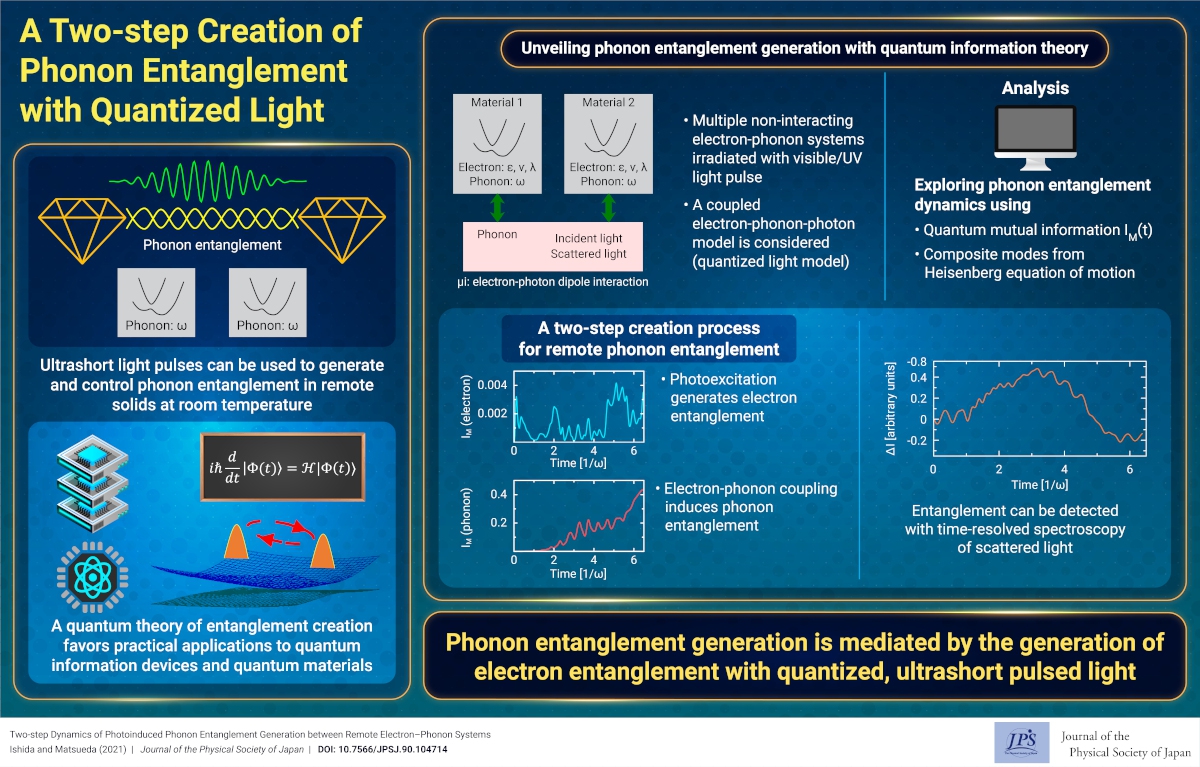A Two-step Creation of Phonon Entanglement with Quantized Light
© The Physical Society of Japan
This article is on
Two-step Dynamics of Photoinduced Phonon Entanglement Generation between Remote Electron-Phonon Systems
(JPSJ Editors' Choice)
J. Phys. Soc. Jpn.
90,
104714
(2021)
.
Dynamics of photoinduced quantum entanglement generation between phonons is theoretically revealed. The results contribute to the study of fundamental theoretical problems within quantum dynamics of photoinduced phase transitions and quantum information science.

Photoinduced phase transition is the cooperative change of the electronic states and/or the crystal structures of a material induced by ultrashort laser pulses. Its mechanism is closely related to the dynamics of elementary excitations which modulate the quantum-mechanical states of strongly correlated electron systems and/or strongly coupled electron-phonon systems in a coherent regime. As slight fluctuations trigger the macroscopic change of the system in phase transitions, the transient dynamics of light-induced fluctuations play an important role in controlling the photoinduced phase transitions. It has been theoretically revealed that the generation dynamics of photoinduced quantum entanglement causes the aforementioned fluctuations.
A model of remote electron-phonon systems which is not directly interacting with each other was selected. The manner in which the entanglement between the phonons of these systems appears as photoirradiation proceeds was calculated. When two systems are sufficiently separated in space, there is no direct quantum-mechanical correlation between them, and the quantum entanglement is generated between them when “quantized light” is irradiated. The problem that requires the quantum nature of light has not been raised frequently although the relationship between the nonequilibrium state and the entanglement is considered a fundamental problem of physics. The results of this study elucidate the role of light quantization on the transient dynamics of condensed matter.
The results of this study will be extended to the study of photoinduced fluctuations leading to macroscopic change of the physical properties or phase transitions. Simultaneously, it is expected to be closely related to the research in the field of quantum information as the proposed theoretical framework is similar to the one for the fundamental problem of quantum information. Specifically, the photoinduced entanglement generation between the remote qubits can be used as a quantum memory. The results of this study show that a large degree of freedom of phonon states will enable a larger quantum entanglement between phonons than qubits, and that an effective quantum entanglement storage/memory is expected. The quantum many-body problems regarding the electrons and bosons (phonons and photons) have a long history, and it is expected that further detailed studies will continue in the future.
(Written by K. Ishida on behalf of all the authors)
Two-step Dynamics of Photoinduced Phonon Entanglement Generation between Remote Electron-Phonon Systems
(JPSJ Editors' Choice)
J. Phys. Soc. Jpn.
90,
104714
(2021)
.
Share this topic
Fields
Related Articles
-
Higher-Order Topological Phases in Magnetic Materials with Breathing Pyrochlore Structures
Electronic structure and electrical properties of surfaces and nanostructures
Magnetic properties in condensed matter
Mathematical methods, classical and quantum physics, relativity, gravitation, numerical simulation, computational modeling
2025-4-7
A simple example of a higher-order topological phase, in which the symmetry decreases step-by-step from the bulk to the corner, is realized in a magnetic system with a pyrochlore structure and is characterized by a series of quantized Berry phases defined for the bulk, surface, and edge.
-
Exploring the Vibrant Interplay of Machine Learning and Physics
Cross-disciplinary physics and related areas of science and technology
Electron states in condensed matter
Elementary particles, fields, and strings
Mathematical methods, classical and quantum physics, relativity, gravitation, numerical simulation, computational modeling
Statistical physics and thermodynamics
Superconductivity
2025-3-13
This Journal of the Physical Society of Japan Special Topics edition explores how physics and machine learning complement each other and can solve unresolved problems in physics.
-
Traffic Signal Optimization using Quantum Annealing
Mathematical methods, classical and quantum physics, relativity, gravitation, numerical simulation, computational modeling
2025-2-25
This paper introduces a QUBO model for traffic signal optimization on real-world maps. Using D-Wave quantum annealing and SUMO simulations, the model reduces vehicle waiting times, but underperforms classical solvers.
-
Shaping the Future of Materials Science with Tanabe–Sugano Diagrams
Dielectric, optical, and other properties in condensed matter
Electron states in condensed matter
Electronic structure and electrical properties of surfaces and nanostructures
Magnetic properties in condensed matter
2025-1-21
This special collection published in the Journal of the Physical Society of Japan celebrates 70 Years of Tanabe–Sugano Diagrams, highlighting their continued role in advancing materials with transition metals.
-
The Stiffness of Electronic Nematicity
Dielectric, optical, and other properties in condensed matter
Electronic structure and electrical properties of surfaces and nanostructures
Electronic transport in condensed matter
2024-11-21
Using laser-excited photoelectron emission microscope (laser-PEEM) we found that the nematic stiffness in iron-based superconductors significantly increases as the systems become strange metals, suggesting that spin–orbital fluctuations enhance the stiffness of electronic nematicity.




